PUBH6004: Leadership and Change Report - Public Health, Torrens Uni
VerifiedAdded on 2021/03/26
|6
|2138
|466
Report
AI Summary
This report, prepared for PUBH6004 at Torrens University, examines leadership and effecting change in public health. It begins by applying the Australian health leadership framework to a case study of Helen, a General Practitioner facing leadership challenges in a multi-ethnic community. The report then utilizes the NHS Leadership Framework Self-Assessment to analyze the author's own leadership style, highlighting strengths in communication and problem-solving. Finally, it reflects on how the author would respond in a similar scenario to Helen, emphasizing the importance of telemedicine, effective communication, and building community relationships. The report concludes that Helen has the potential to be a successful leader, but needs to focus on making her ideas work and creating strong connections.
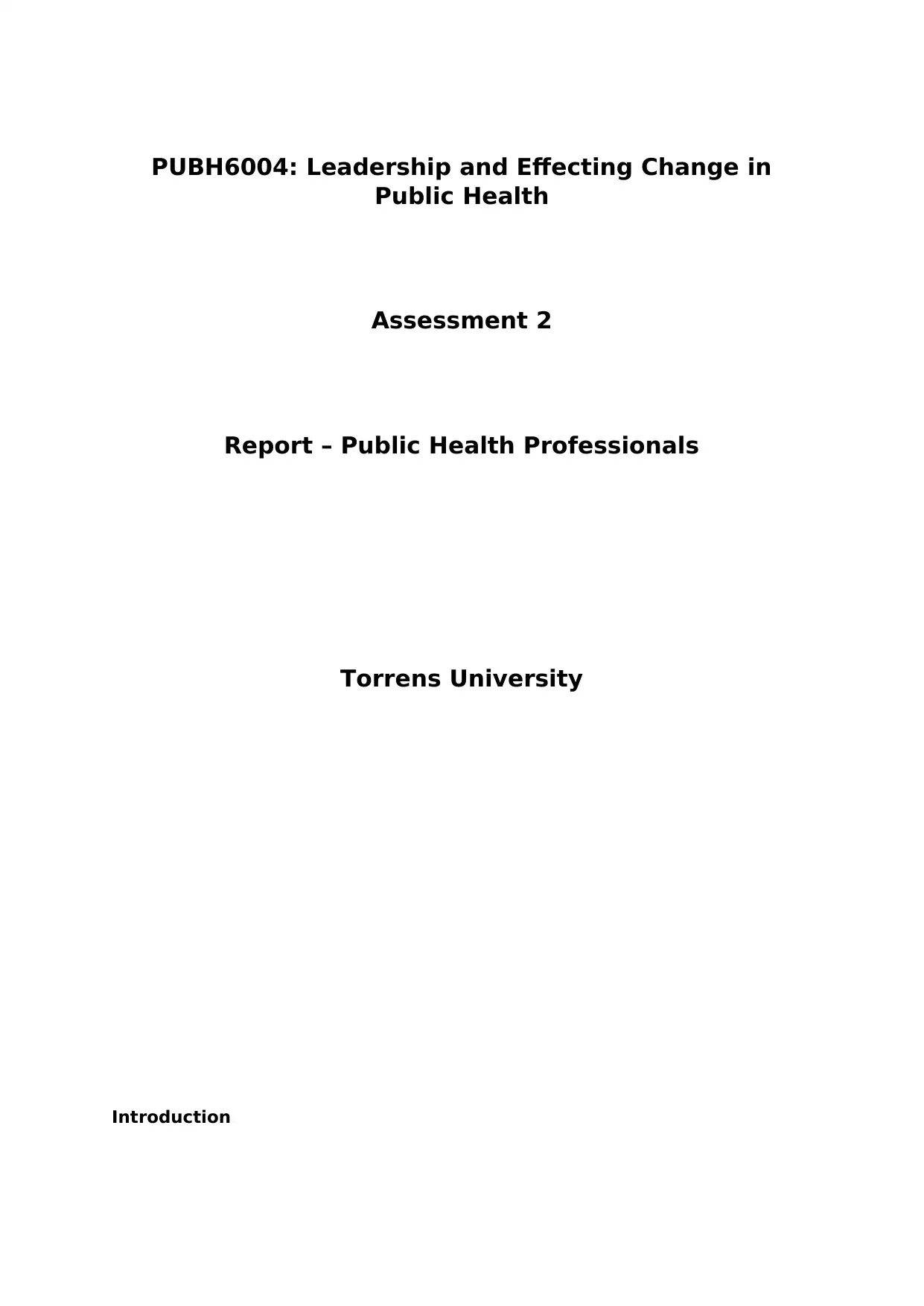
PUBH6004: Leadership and Effecting Change in
Public Health
Assessment 2
Report – Public Health Professionals
Torrens University
Introduction
Public Health
Assessment 2
Report – Public Health Professionals
Torrens University
Introduction
Paraphrase This Document
Need a fresh take? Get an instant paraphrase of this document with our AI Paraphraser
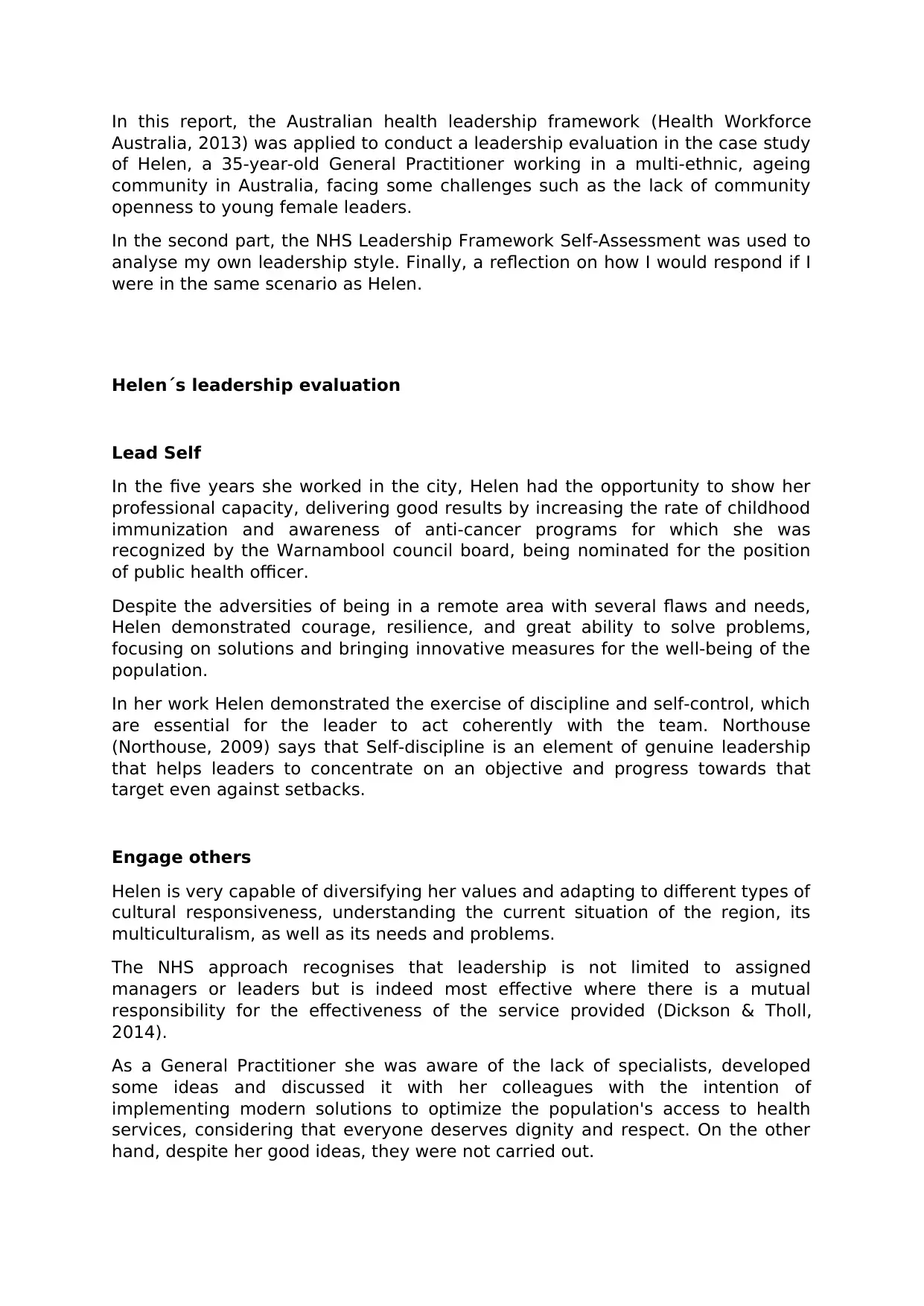
In this report, the Australian health leadership framework (Health Workforce
Australia, 2013) was applied to conduct a leadership evaluation in the case study
of Helen, a 35-year-old General Practitioner working in a multi-ethnic, ageing
community in Australia, facing some challenges such as the lack of community
openness to young female leaders.
In the second part, the NHS Leadership Framework Self-Assessment was used to
analyse my own leadership style. Finally, a reflection on how I would respond if I
were in the same scenario as Helen.
Helen´s leadership evaluation
Lead Self
In the five years she worked in the city, Helen had the opportunity to show her
professional capacity, delivering good results by increasing the rate of childhood
immunization and awareness of anti-cancer programs for which she was
recognized by the Warnambool council board, being nominated for the position
of public health officer.
Despite the adversities of being in a remote area with several flaws and needs,
Helen demonstrated courage, resilience, and great ability to solve problems,
focusing on solutions and bringing innovative measures for the well-being of the
population.
In her work Helen demonstrated the exercise of discipline and self-control, which
are essential for the leader to act coherently with the team. Northouse
(Northouse, 2009) says that Self-discipline is an element of genuine leadership
that helps leaders to concentrate on an objective and progress towards that
target even against setbacks.
Engage others
Helen is very capable of diversifying her values and adapting to different types of
cultural responsiveness, understanding the current situation of the region, its
multiculturalism, as well as its needs and problems.
The NHS approach recognises that leadership is not limited to assigned
managers or leaders but is indeed most effective where there is a mutual
responsibility for the effectiveness of the service provided (Dickson & Tholl,
2014).
As a General Practitioner she was aware of the lack of specialists, developed
some ideas and discussed it with her colleagues with the intention of
implementing modern solutions to optimize the population's access to health
services, considering that everyone deserves dignity and respect. On the other
hand, despite her good ideas, they were not carried out.
Australia, 2013) was applied to conduct a leadership evaluation in the case study
of Helen, a 35-year-old General Practitioner working in a multi-ethnic, ageing
community in Australia, facing some challenges such as the lack of community
openness to young female leaders.
In the second part, the NHS Leadership Framework Self-Assessment was used to
analyse my own leadership style. Finally, a reflection on how I would respond if I
were in the same scenario as Helen.
Helen´s leadership evaluation
Lead Self
In the five years she worked in the city, Helen had the opportunity to show her
professional capacity, delivering good results by increasing the rate of childhood
immunization and awareness of anti-cancer programs for which she was
recognized by the Warnambool council board, being nominated for the position
of public health officer.
Despite the adversities of being in a remote area with several flaws and needs,
Helen demonstrated courage, resilience, and great ability to solve problems,
focusing on solutions and bringing innovative measures for the well-being of the
population.
In her work Helen demonstrated the exercise of discipline and self-control, which
are essential for the leader to act coherently with the team. Northouse
(Northouse, 2009) says that Self-discipline is an element of genuine leadership
that helps leaders to concentrate on an objective and progress towards that
target even against setbacks.
Engage others
Helen is very capable of diversifying her values and adapting to different types of
cultural responsiveness, understanding the current situation of the region, its
multiculturalism, as well as its needs and problems.
The NHS approach recognises that leadership is not limited to assigned
managers or leaders but is indeed most effective where there is a mutual
responsibility for the effectiveness of the service provided (Dickson & Tholl,
2014).
As a General Practitioner she was aware of the lack of specialists, developed
some ideas and discussed it with her colleagues with the intention of
implementing modern solutions to optimize the population's access to health
services, considering that everyone deserves dignity and respect. On the other
hand, despite her good ideas, they were not carried out.
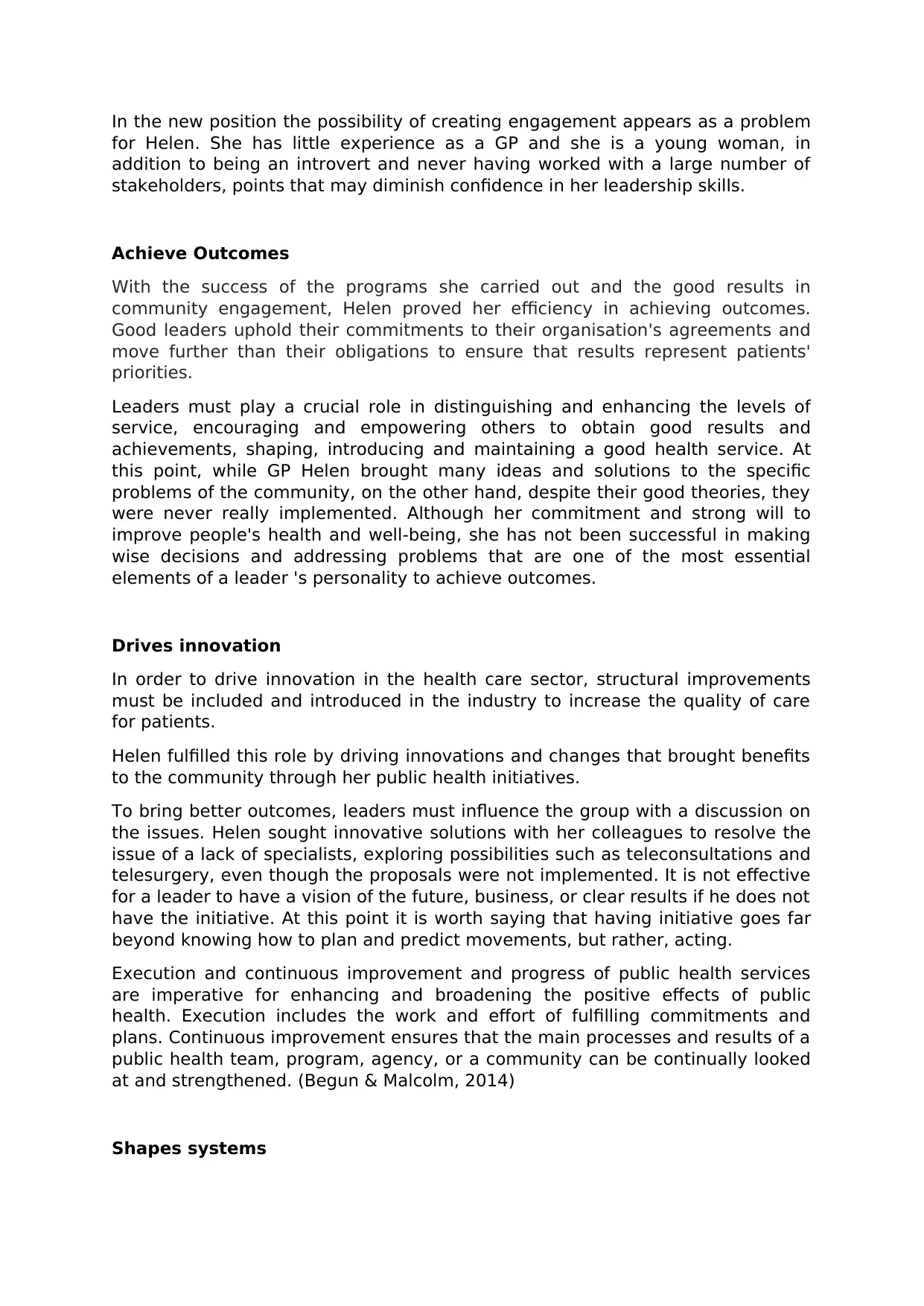
In the new position the possibility of creating engagement appears as a problem
for Helen. She has little experience as a GP and she is a young woman, in
addition to being an introvert and never having worked with a large number of
stakeholders, points that may diminish confidence in her leadership skills.
Achieve Outcomes
With the success of the programs she carried out and the good results in
community engagement, Helen proved her efficiency in achieving outcomes.
Good leaders uphold their commitments to their organisation's agreements and
move further than their obligations to ensure that results represent patients'
priorities.
Leaders must play a crucial role in distinguishing and enhancing the levels of
service, encouraging and empowering others to obtain good results and
achievements, shaping, introducing and maintaining a good health service. At
this point, while GP Helen brought many ideas and solutions to the specific
problems of the community, on the other hand, despite their good theories, they
were never really implemented. Although her commitment and strong will to
improve people's health and well-being, she has not been successful in making
wise decisions and addressing problems that are one of the most essential
elements of a leader 's personality to achieve outcomes.
Drives innovation
In order to drive innovation in the health care sector, structural improvements
must be included and introduced in the industry to increase the quality of care
for patients.
Helen fulfilled this role by driving innovations and changes that brought benefits
to the community through her public health initiatives.
To bring better outcomes, leaders must influence the group with a discussion on
the issues. Helen sought innovative solutions with her colleagues to resolve the
issue of a lack of specialists, exploring possibilities such as teleconsultations and
telesurgery, even though the proposals were not implemented. It is not effective
for a leader to have a vision of the future, business, or clear results if he does not
have the initiative. At this point it is worth saying that having initiative goes far
beyond knowing how to plan and predict movements, but rather, acting.
Execution and continuous improvement and progress of public health services
are imperative for enhancing and broadening the positive effects of public
health. Execution includes the work and effort of fulfilling commitments and
plans. Continuous improvement ensures that the main processes and results of a
public health team, program, agency, or a community can be continually looked
at and strengthened. (Begun & Malcolm, 2014)
Shapes systems
for Helen. She has little experience as a GP and she is a young woman, in
addition to being an introvert and never having worked with a large number of
stakeholders, points that may diminish confidence in her leadership skills.
Achieve Outcomes
With the success of the programs she carried out and the good results in
community engagement, Helen proved her efficiency in achieving outcomes.
Good leaders uphold their commitments to their organisation's agreements and
move further than their obligations to ensure that results represent patients'
priorities.
Leaders must play a crucial role in distinguishing and enhancing the levels of
service, encouraging and empowering others to obtain good results and
achievements, shaping, introducing and maintaining a good health service. At
this point, while GP Helen brought many ideas and solutions to the specific
problems of the community, on the other hand, despite their good theories, they
were never really implemented. Although her commitment and strong will to
improve people's health and well-being, she has not been successful in making
wise decisions and addressing problems that are one of the most essential
elements of a leader 's personality to achieve outcomes.
Drives innovation
In order to drive innovation in the health care sector, structural improvements
must be included and introduced in the industry to increase the quality of care
for patients.
Helen fulfilled this role by driving innovations and changes that brought benefits
to the community through her public health initiatives.
To bring better outcomes, leaders must influence the group with a discussion on
the issues. Helen sought innovative solutions with her colleagues to resolve the
issue of a lack of specialists, exploring possibilities such as teleconsultations and
telesurgery, even though the proposals were not implemented. It is not effective
for a leader to have a vision of the future, business, or clear results if he does not
have the initiative. At this point it is worth saying that having initiative goes far
beyond knowing how to plan and predict movements, but rather, acting.
Execution and continuous improvement and progress of public health services
are imperative for enhancing and broadening the positive effects of public
health. Execution includes the work and effort of fulfilling commitments and
plans. Continuous improvement ensures that the main processes and results of a
public health team, program, agency, or a community can be continually looked
at and strengthened. (Begun & Malcolm, 2014)
Shapes systems
⊘ This is a preview!⊘
Do you want full access?
Subscribe today to unlock all pages.

Trusted by 1+ million students worldwide
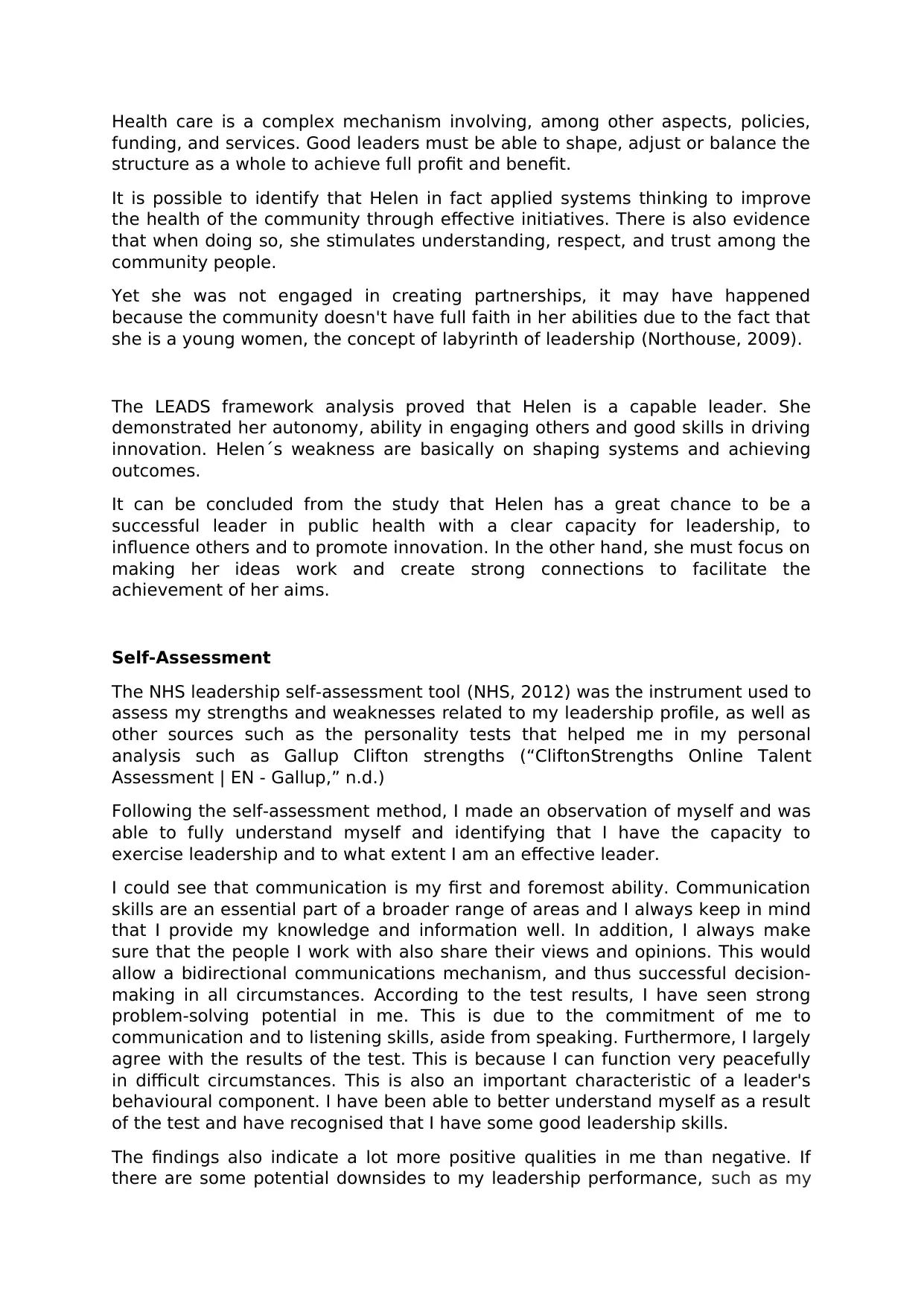
Health care is a complex mechanism involving, among other aspects, policies,
funding, and services. Good leaders must be able to shape, adjust or balance the
structure as a whole to achieve full profit and benefit.
It is possible to identify that Helen in fact applied systems thinking to improve
the health of the community through effective initiatives. There is also evidence
that when doing so, she stimulates understanding, respect, and trust among the
community people.
Yet she was not engaged in creating partnerships, it may have happened
because the community doesn't have full faith in her abilities due to the fact that
she is a young women, the concept of labyrinth of leadership (Northouse, 2009).
The LEADS framework analysis proved that Helen is a capable leader. She
demonstrated her autonomy, ability in engaging others and good skills in driving
innovation. Helen´s weakness are basically on shaping systems and achieving
outcomes.
It can be concluded from the study that Helen has a great chance to be a
successful leader in public health with a clear capacity for leadership, to
influence others and to promote innovation. In the other hand, she must focus on
making her ideas work and create strong connections to facilitate the
achievement of her aims.
Self-Assessment
The NHS leadership self-assessment tool (NHS, 2012) was the instrument used to
assess my strengths and weaknesses related to my leadership profile, as well as
other sources such as the personality tests that helped me in my personal
analysis such as Gallup Clifton strengths (“CliftonStrengths Online Talent
Assessment | EN - Gallup,” n.d.)
Following the self-assessment method, I made an observation of myself and was
able to fully understand myself and identifying that I have the capacity to
exercise leadership and to what extent I am an effective leader.
I could see that communication is my first and foremost ability. Communication
skills are an essential part of a broader range of areas and I always keep in mind
that I provide my knowledge and information well. In addition, I always make
sure that the people I work with also share their views and opinions. This would
allow a bidirectional communications mechanism, and thus successful decision-
making in all circumstances. According to the test results, I have seen strong
problem-solving potential in me. This is due to the commitment of me to
communication and to listening skills, aside from speaking. Furthermore, I largely
agree with the results of the test. This is because I can function very peacefully
in difficult circumstances. This is also an important characteristic of a leader's
behavioural component. I have been able to better understand myself as a result
of the test and have recognised that I have some good leadership skills.
The findings also indicate a lot more positive qualities in me than negative. If
there are some potential downsides to my leadership performance, such as my
funding, and services. Good leaders must be able to shape, adjust or balance the
structure as a whole to achieve full profit and benefit.
It is possible to identify that Helen in fact applied systems thinking to improve
the health of the community through effective initiatives. There is also evidence
that when doing so, she stimulates understanding, respect, and trust among the
community people.
Yet she was not engaged in creating partnerships, it may have happened
because the community doesn't have full faith in her abilities due to the fact that
she is a young women, the concept of labyrinth of leadership (Northouse, 2009).
The LEADS framework analysis proved that Helen is a capable leader. She
demonstrated her autonomy, ability in engaging others and good skills in driving
innovation. Helen´s weakness are basically on shaping systems and achieving
outcomes.
It can be concluded from the study that Helen has a great chance to be a
successful leader in public health with a clear capacity for leadership, to
influence others and to promote innovation. In the other hand, she must focus on
making her ideas work and create strong connections to facilitate the
achievement of her aims.
Self-Assessment
The NHS leadership self-assessment tool (NHS, 2012) was the instrument used to
assess my strengths and weaknesses related to my leadership profile, as well as
other sources such as the personality tests that helped me in my personal
analysis such as Gallup Clifton strengths (“CliftonStrengths Online Talent
Assessment | EN - Gallup,” n.d.)
Following the self-assessment method, I made an observation of myself and was
able to fully understand myself and identifying that I have the capacity to
exercise leadership and to what extent I am an effective leader.
I could see that communication is my first and foremost ability. Communication
skills are an essential part of a broader range of areas and I always keep in mind
that I provide my knowledge and information well. In addition, I always make
sure that the people I work with also share their views and opinions. This would
allow a bidirectional communications mechanism, and thus successful decision-
making in all circumstances. According to the test results, I have seen strong
problem-solving potential in me. This is due to the commitment of me to
communication and to listening skills, aside from speaking. Furthermore, I largely
agree with the results of the test. This is because I can function very peacefully
in difficult circumstances. This is also an important characteristic of a leader's
behavioural component. I have been able to better understand myself as a result
of the test and have recognised that I have some good leadership skills.
The findings also indicate a lot more positive qualities in me than negative. If
there are some potential downsides to my leadership performance, such as my
Paraphrase This Document
Need a fresh take? Get an instant paraphrase of this document with our AI Paraphraser
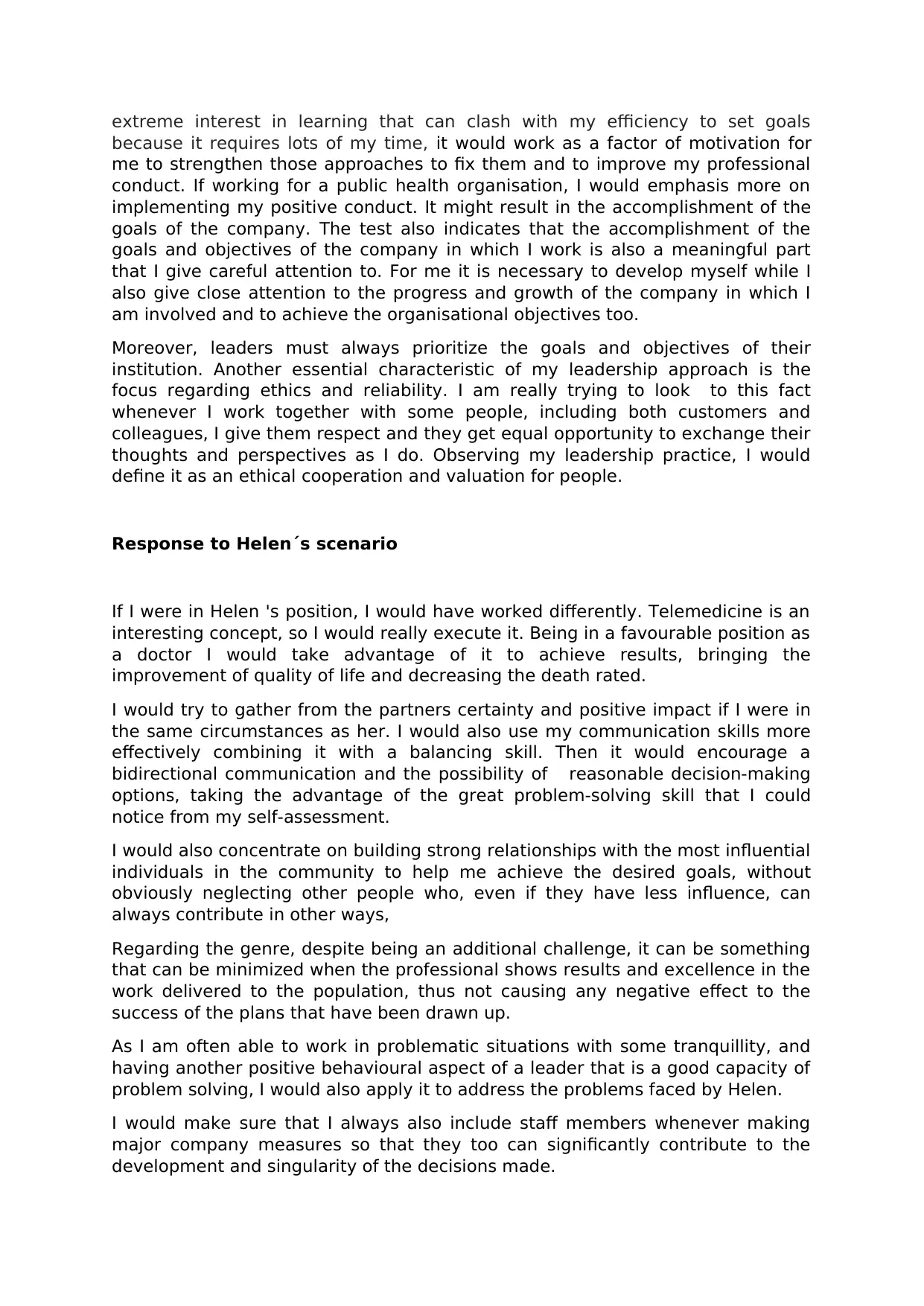
extreme interest in learning that can clash with my efficiency to set goals
because it requires lots of my time, it would work as a factor of motivation for
me to strengthen those approaches to fix them and to improve my professional
conduct. If working for a public health organisation, I would emphasis more on
implementing my positive conduct. It might result in the accomplishment of the
goals of the company. The test also indicates that the accomplishment of the
goals and objectives of the company in which I work is also a meaningful part
that I give careful attention to. For me it is necessary to develop myself while I
also give close attention to the progress and growth of the company in which I
am involved and to achieve the organisational objectives too.
Moreover, leaders must always prioritize the goals and objectives of their
institution. Another essential characteristic of my leadership approach is the
focus regarding ethics and reliability. I am really trying to look to this fact
whenever I work together with some people, including both customers and
colleagues, I give them respect and they get equal opportunity to exchange their
thoughts and perspectives as I do. Observing my leadership practice, I would
define it as an ethical cooperation and valuation for people.
Response to Helen´s scenario
If I were in Helen 's position, I would have worked differently. Telemedicine is an
interesting concept, so I would really execute it. Being in a favourable position as
a doctor I would take advantage of it to achieve results, bringing the
improvement of quality of life and decreasing the death rated.
I would try to gather from the partners certainty and positive impact if I were in
the same circumstances as her. I would also use my communication skills more
effectively combining it with a balancing skill. Then it would encourage a
bidirectional communication and the possibility of reasonable decision-making
options, taking the advantage of the great problem-solving skill that I could
notice from my self-assessment.
I would also concentrate on building strong relationships with the most influential
individuals in the community to help me achieve the desired goals, without
obviously neglecting other people who, even if they have less influence, can
always contribute in other ways,
Regarding the genre, despite being an additional challenge, it can be something
that can be minimized when the professional shows results and excellence in the
work delivered to the population, thus not causing any negative effect to the
success of the plans that have been drawn up.
As I am often able to work in problematic situations with some tranquillity, and
having another positive behavioural aspect of a leader that is a good capacity of
problem solving, I would also apply it to address the problems faced by Helen.
I would make sure that I always also include staff members whenever making
major company measures so that they too can significantly contribute to the
development and singularity of the decisions made.
because it requires lots of my time, it would work as a factor of motivation for
me to strengthen those approaches to fix them and to improve my professional
conduct. If working for a public health organisation, I would emphasis more on
implementing my positive conduct. It might result in the accomplishment of the
goals of the company. The test also indicates that the accomplishment of the
goals and objectives of the company in which I work is also a meaningful part
that I give careful attention to. For me it is necessary to develop myself while I
also give close attention to the progress and growth of the company in which I
am involved and to achieve the organisational objectives too.
Moreover, leaders must always prioritize the goals and objectives of their
institution. Another essential characteristic of my leadership approach is the
focus regarding ethics and reliability. I am really trying to look to this fact
whenever I work together with some people, including both customers and
colleagues, I give them respect and they get equal opportunity to exchange their
thoughts and perspectives as I do. Observing my leadership practice, I would
define it as an ethical cooperation and valuation for people.
Response to Helen´s scenario
If I were in Helen 's position, I would have worked differently. Telemedicine is an
interesting concept, so I would really execute it. Being in a favourable position as
a doctor I would take advantage of it to achieve results, bringing the
improvement of quality of life and decreasing the death rated.
I would try to gather from the partners certainty and positive impact if I were in
the same circumstances as her. I would also use my communication skills more
effectively combining it with a balancing skill. Then it would encourage a
bidirectional communication and the possibility of reasonable decision-making
options, taking the advantage of the great problem-solving skill that I could
notice from my self-assessment.
I would also concentrate on building strong relationships with the most influential
individuals in the community to help me achieve the desired goals, without
obviously neglecting other people who, even if they have less influence, can
always contribute in other ways,
Regarding the genre, despite being an additional challenge, it can be something
that can be minimized when the professional shows results and excellence in the
work delivered to the population, thus not causing any negative effect to the
success of the plans that have been drawn up.
As I am often able to work in problematic situations with some tranquillity, and
having another positive behavioural aspect of a leader that is a good capacity of
problem solving, I would also apply it to address the problems faced by Helen.
I would make sure that I always also include staff members whenever making
major company measures so that they too can significantly contribute to the
development and singularity of the decisions made.
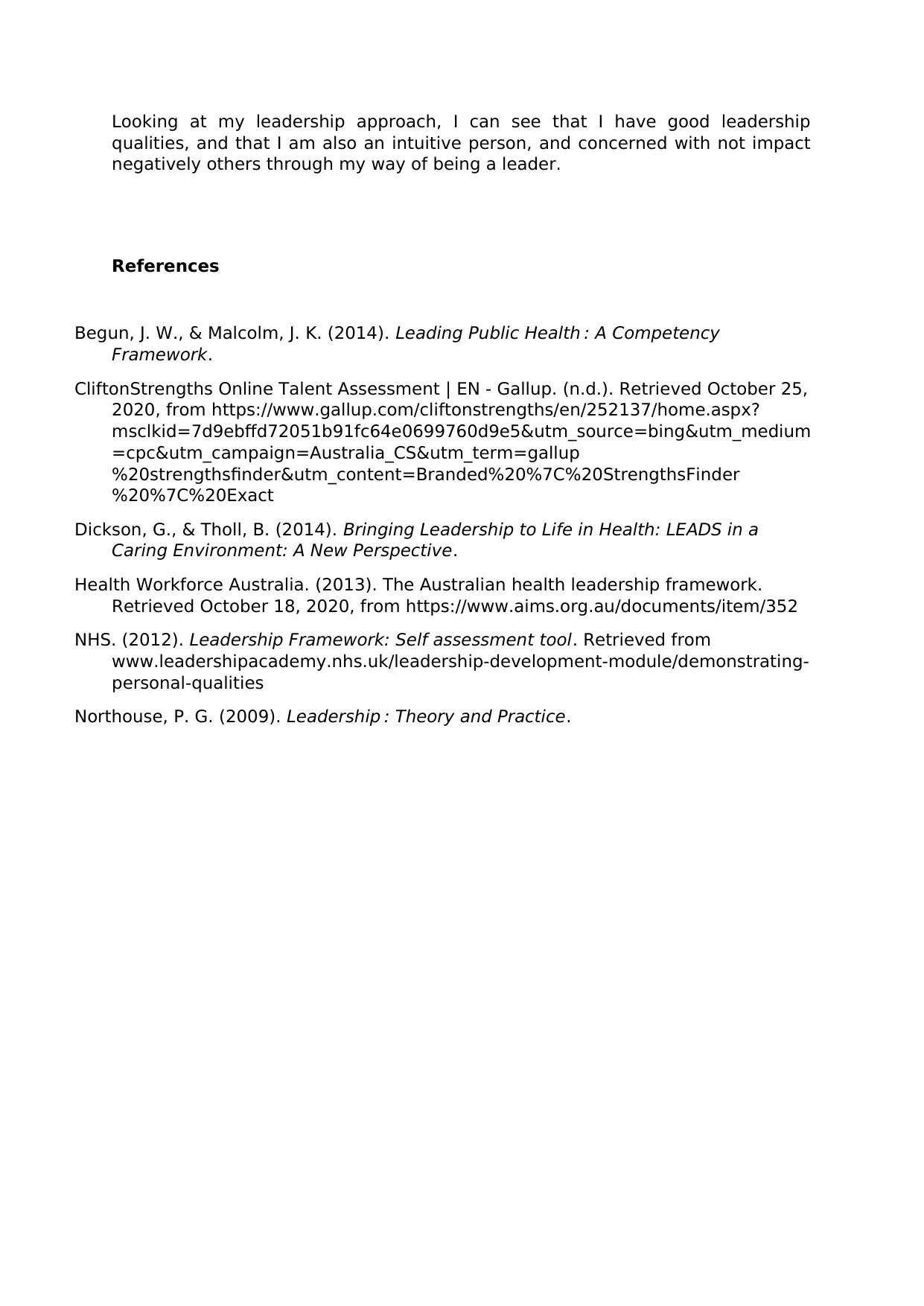
Looking at my leadership approach, I can see that I have good leadership
qualities, and that I am also an intuitive person, and concerned with not impact
negatively others through my way of being a leader.
References
Begun, J. W., & Malcolm, J. K. (2014). Leading Public Health : A Competency
Framework.
CliftonStrengths Online Talent Assessment | EN - Gallup. (n.d.). Retrieved October 25,
2020, from https://www.gallup.com/cliftonstrengths/en/252137/home.aspx?
msclkid=7d9ebffd72051b91fc64e0699760d9e5&utm_source=bing&utm_medium
=cpc&utm_campaign=Australia_CS&utm_term=gallup
%20strengthsfinder&utm_content=Branded%20%7C%20StrengthsFinder
%20%7C%20Exact
Dickson, G., & Tholl, B. (2014). Bringing Leadership to Life in Health: LEADS in a
Caring Environment: A New Perspective.
Health Workforce Australia. (2013). The Australian health leadership framework.
Retrieved October 18, 2020, from https://www.aims.org.au/documents/item/352
NHS. (2012). Leadership Framework: Self assessment tool. Retrieved from
www.leadershipacademy.nhs.uk/leadership-development-module/demonstrating-
personal-qualities
Northouse, P. G. (2009). Leadership : Theory and Practice.
qualities, and that I am also an intuitive person, and concerned with not impact
negatively others through my way of being a leader.
References
Begun, J. W., & Malcolm, J. K. (2014). Leading Public Health : A Competency
Framework.
CliftonStrengths Online Talent Assessment | EN - Gallup. (n.d.). Retrieved October 25,
2020, from https://www.gallup.com/cliftonstrengths/en/252137/home.aspx?
msclkid=7d9ebffd72051b91fc64e0699760d9e5&utm_source=bing&utm_medium
=cpc&utm_campaign=Australia_CS&utm_term=gallup
%20strengthsfinder&utm_content=Branded%20%7C%20StrengthsFinder
%20%7C%20Exact
Dickson, G., & Tholl, B. (2014). Bringing Leadership to Life in Health: LEADS in a
Caring Environment: A New Perspective.
Health Workforce Australia. (2013). The Australian health leadership framework.
Retrieved October 18, 2020, from https://www.aims.org.au/documents/item/352
NHS. (2012). Leadership Framework: Self assessment tool. Retrieved from
www.leadershipacademy.nhs.uk/leadership-development-module/demonstrating-
personal-qualities
Northouse, P. G. (2009). Leadership : Theory and Practice.
⊘ This is a preview!⊘
Do you want full access?
Subscribe today to unlock all pages.

Trusted by 1+ million students worldwide
1 out of 6
Related Documents
Your All-in-One AI-Powered Toolkit for Academic Success.
+13062052269
info@desklib.com
Available 24*7 on WhatsApp / Email
![[object Object]](/_next/static/media/star-bottom.7253800d.svg)
Unlock your academic potential
Copyright © 2020–2025 A2Z Services. All Rights Reserved. Developed and managed by ZUCOL.





